 She could tell them the secret but it would be a bad Korea move. 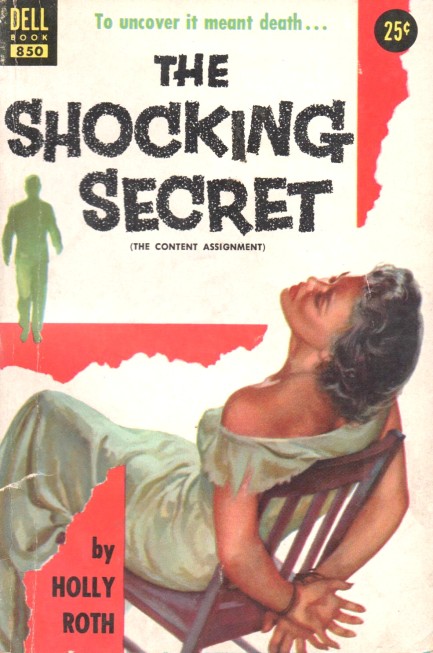
Holly Roth, who also wrote as P.J. Merrill and K.G. Ballard, originally published The Shocking Secret as The Content Assignment in 1954. This Dell edition came in 1955 with William Rose cover art. The story, set beginning in 1948, deals with John Terrant, a British reporter in Berlin whose American love Ellen Content is a CIA agent who disappears during a mission. Nearly two years later her name turns up in a newspaper story that says she's a dancer in New York City. So Terrant crosses the pond to track her down but ends up in the middle of the Cold War, with bad commies and the whole nine.
Roth infuses her tale with an Englishman in New York fish-out-of-water quality, which is occasionally amusing and adds interest, but in the end the entire enterprise comes across lightweight—which is to say it lacks menace and the proper amount of intellectual heft needed for a book about the political/ideological clash of the era. And another issue, though an admittedly nit-picky one, is that the surprise of the title, which we mostly gave away in our subhead, isn't all that shocking. Dell never should have renamed the book.
Moving on to Roth herself, she's one of those writers whose life had an eerie parallel with her fiction. Her 1962 novel Too Many Doctors is about a woman who falls off a ship and loses her memory. In 1964 Roth disappeared from her husband's yacht one stormy night off the coast of Morocco and was never seen again. Officially, her death was an accident. If we get ambitious maybe we'll read Too Many Doctors. While we can't recommend The Shocking Secret, we wouldn't be surprised if several of her other books are better. Her reputation would seem to suggest it.

 She's old enough to know better but too young to care. 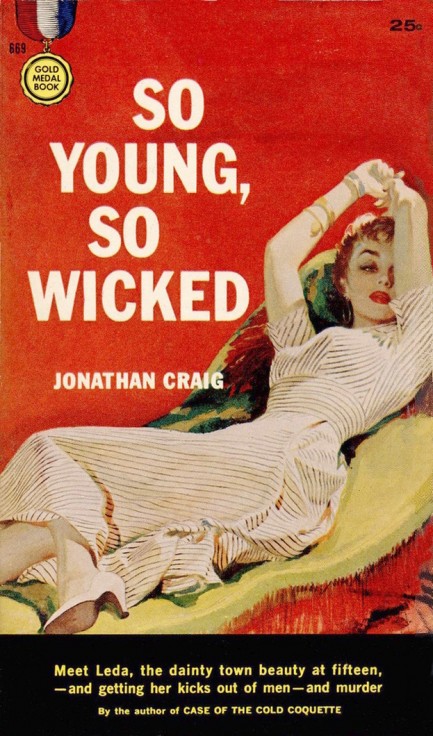
So Young, So Wicked is a book we were looking forward to because our previous forays into Jonathan Craig's work were fun. In this one a mafia hitman named Steve Garrity is given a rush job—kill fifteen-year-old Lena Noland, and make it look like an accident. Will he drown her? Push her down some stairs? Run her over? The problem isn't so much choice of method, but having to operate in a small town where strangers tend to be noticed by everyone, and the local piggly wiggly are always on the lookout for big city troublemakers. Therefore Garrity takes the only approach he can—he romances Leda's aunt and legal guardian Nancy so he has a logical reason to be hanging around.
It occasionally happens that a title works against an author, and this is one of those cases. Thanks to the title, we don't have to tell you that Lena is not your typical clueless fifteen-year-old. Craig writes her as a sexually precocious but seemingly sweet girl, however Wicked has been implanted in your head from the moment you saw the book on a secondhand rack, so you know there's more to her than the reader—or crucially, Garrity—suspects. The rear cover also pulls that trick, describing Lena as deadly. Therefore, what Craig clearly meant to be twists have less impact than we'd have liked.
But, fine, Leda is wicked and deadly. You still have to find out in exactly what ways. Compared to other Craigs we've read, though, So Young, So Wicked is a concept that doesn't come to fruition. Partly it's knowing Leda is a very bad girl, but partly it's the writing. Craig does that thing where characters constantly use each others' names in dialogue (“Tell me why you feel that way, Steve.” “Well, Lena, I don't know if I can explain it.” “Try, Steve.”) It reads weird, but the book is basically fine. We just expected more from the guy who wrote Red-Headed Sinners and Alley Girl. This Gold Medal edition is from 1957 and the wrapaound art is by William Rose.
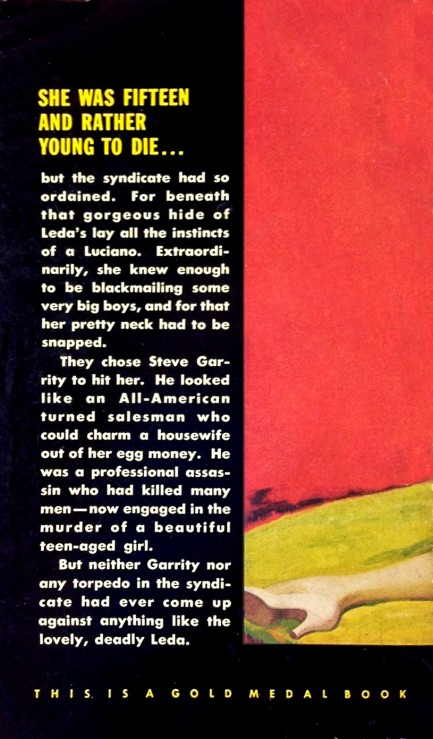
 Human nature red in tooth and claw. 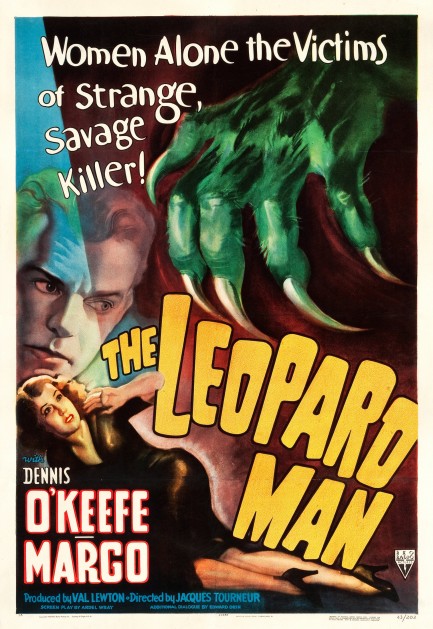
Whenever we have minimal expectations of a film and receive reasonable entertainment we're reminded why we like watching old movies so much. In The Leopard Man, for which you see a striking William Rose poster above, a New Mexico nightclub chanteuse loses her feline sidekick and it soon begins prowling the desert night and savaging women. Or is it? Pretty soon the singer and her manager begin to wonder if the leopard is being blamed for killings committed by someone—or something—else. The movie feels a bit like Cat People, which makes sense, because director Jacques Tourneur helmed both productions. But where Cat People was set in New York City, this one has a bordertown flavor, with flamenco music and various Mexican and Spanish characters in scattered roles, including Margo—just Margo—who was Spanish bandleader Xavier Cugat's niece. The solution to the mystery comes in a climax set against the town's creepy Spanish processions. It turns out the killer is a someone, not a something, but that was never truly in doubt. At just over an hour in length the movie is a pretty nice time killer, but the shorthand feel of it also shows why feature films tend to be longer. The Leopard Man premiered in the U.S. today in 1943.
   
 Phillip Marlowe gets involved in shady business. 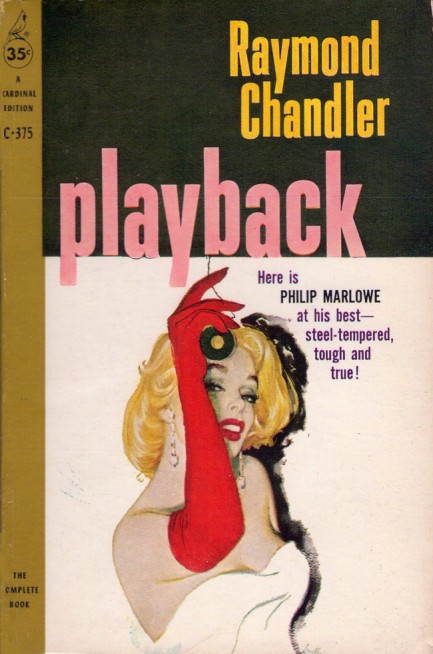
Above, a very nice piece of William Rose cover art incorporating a window shade for Raymond Chandler's Playback, from Cardinal Books, 1960. This is the last Phillip Marlowe novel Chandler wrote. It first appeared in Britain in 1958 as a hardback. Basically, it's a missing persons case set in California in which Marlowe is put on the trail of a woman being pursued by various shady figures from her past. Many critics consider it lesser Chandler, but it has its plusses. The mystery blog Bloody Murder agrees, and you can read a detailed positive review there by following this link.
 Change is inevitable—especially if you're dealing with Ian Fleming. 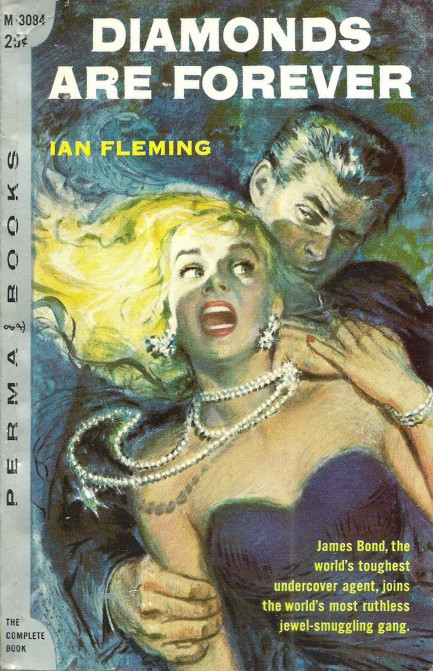
Ian Fleming was not an author to be trifled with. We talked about how he shifted the rights for Casino Royale from Popular Library to Signet. Well, here we go again. The above 1957 Perma paperback of Diamonds Are Forever with excellent William Rose cover art is rare because Fleming shifted the publishing to Signet after Perma changed the title of Moonraker to Too Hot to Handle. Since this happened after the Casino Royale fiasco you’d think the editors would have known better. Perma: Ian, Moonraker is a terrible title. It sounds like a sci-fi novel. Fleming: You listen here, you sniveling little pup— Perma: This is my job, okay. I’m telling you a bad title hurts your whole brand. Fleming: Well, I have an idea for a book called Goldfinger. I suppose you think that’s a bad title too? Perma: Well, yeah... Fleming: Why you annoying insect. And Octopussy? You don’t like that either? Perma: Sounds pornographic. It’s ludicrous. Fleming: You have two tin fucking ears is what’s ludicrous! And Chitty-Chitty-Bang-Bang? Perma: The worst of the bunch, and pornographic. I’m sorry, Ian— Fleming: Chitty-Chitty-Bang-Bang? Pornographic? That’s the last goddamned straw, you pimply little Yank!
 Okay, *gasp*, you win, *wheeze*, there is a tide… 
Evocative cover art painted by William Rose for Agatha Christie’s 1948 mystery There Is a Tide, aka Taken at the Flood. Other possible akas include: I Was Only Choking My Dear, All Hands on Neck, and Squish You Were Here. Are we lucky or just good?
|
 |

The headlines that mattered yesteryear.
1945—Churchill Given the Sack
In spite of admiring Winston Churchill as a great wartime leader, Britons elect
Clement Attlee the nation's new prime minister in a sweeping victory for the Labour Party over the Conservatives. 1952—Evita Peron Dies
Eva Duarte de Peron, aka Evita, wife of the president of the Argentine Republic, dies from cancer at age 33. Evita had brought the working classes into a position of political power never witnessed before, but was hated by the nation's powerful military class. She is lain to rest in Milan, Italy in a secret grave under a nun's name, but is eventually returned to Argentina for reburial beside her husband in 1974. 1943—Mussolini Calls It Quits
Italian dictator Benito Mussolini steps down as head of the armed forces and the government. It soon becomes clear that Il Duce did not relinquish power voluntarily, but was forced to resign after former Fascist colleagues turned against him. He is later installed by Germany as leader of the Italian Social Republic in the north of the country, but is killed by partisans in 1945. 1915—Ship Capsizes on Lake Michigan
During an outing arranged by Western Electric Co. for its employees and their families, the passenger ship Eastland capsizes in Lake Michigan due to unequal weight distribution. 844 people die, including all the members of 22 different families. 1980—Peter Sellers Dies
British movie star Peter Sellers, whose roles in Dr. Strangelove, Being There and the Pink Panther films established him as the greatest comedic actor of his generation, dies of a heart attack at age fifty-four.
|

|
|

It's easy. We have an uploader that makes it a snap. Use it to submit your art, text, header, and subhead. Your post can be funny, serious, or anything in between, as long as it's vintage pulp. You'll get a byline and experience the fleeting pride of free authorship. We'll edit your post for typos, but the rest is up to you. Click here to give us your best shot.

|
|






















































































